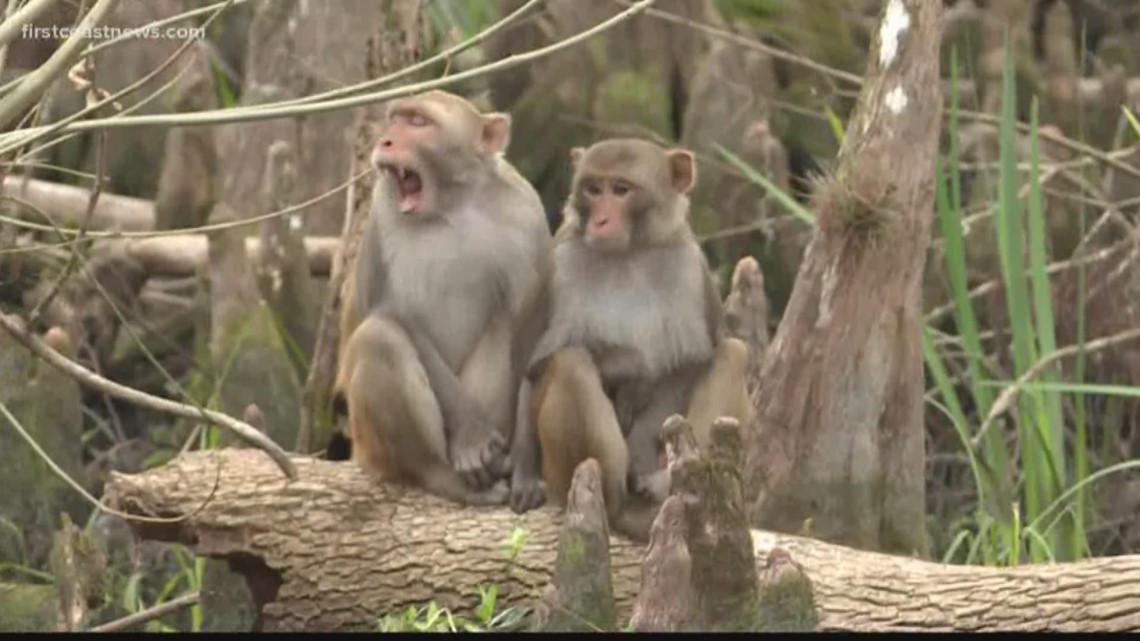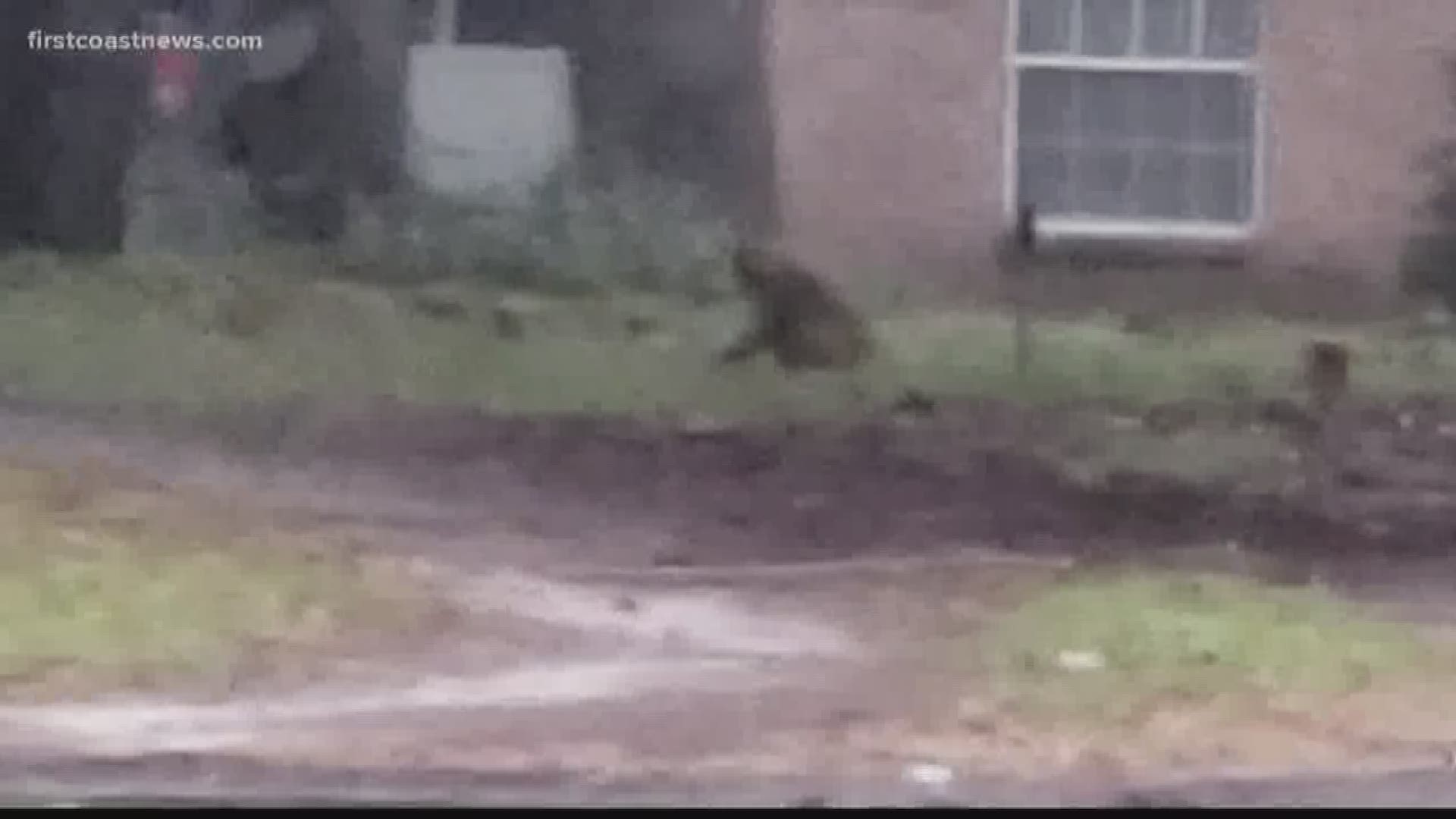JACKSONVILLE, Fla. — There’s a new resident in the Julington Creek neighborhood Jacksonville. Also in St. Johns, St. Augustine, Palatka, Welaka and Elkton.
In all, a dozen confirmed sightings of a feral, invasive monkey species: the rhesus macaque.
Videos and photographs – grainy and shaky, shot by homeowners – track the trail of a species expansion that experts call concerning and possibly dangerous.
“The potential ramifications are really dire,” University of Florida wildlife ecologist Dr. Steve Johnson told First Coat News. “A big male like the one in that video in Jacksonville -- that’s an extremely strong, potentially dangerous animal.”
First Coast News obtained two videos and several photographs taken of the monkeys. Florida Fish and Wildlife Conservation Commission (FWC) officials call the reports credible, a likely expansion of the feral monkey population in Central Florida.
Rheseus macaques were first introduced to Silver Springs State Park in the late 1930s when a tour boat operator named Colonel Tooey released six of them on a manmade island as a tourist attraction. He released another six a decade later.
“Guess what?” laughs Johnson. “They can swim. They left the island.”
The monkeys have lived in the state park ever since – alternately mesmerizing and terrifying parkgoers. They’ve also ranged well beyond the park boundaries, with sightings far as Tampa and Apopka.
But this is the first time the monkeys have been reported on the First Coast.
Julington Creek resident Carrie Bennett is admittedly wary of the primates. “That is definitely a concern because I walk the dogs at like 5:30 in the morning and its pitch blackout,” she said. “If they bit me, if they came after and bit you, you don’t know what they have, what they’re carrying.”
In fact, the monkeys carry -- and shed -- the Herpes B virus, which can be fatal to humans. It’s what Johnson calls a “low risk, high consequence” possibility. The animals are also physically imposing with “strong arms, a very strong bite [and] large canine teeth.”
Monkeys tend to be skittish around humans, but they are adaptable and smart. Johnson’s research shows the Silver Springs monkeys actually frequent the river more often on weekends when park visitors – and their snacks -- are at their peak.
One video of the Julington Creek monkey shows a dog-sized creature snacking on oranges fallen from a tree. Another shows it swinging through the treetops.
“I was shocked, totally shocked -- it was a bigger monkey than I thought it would be,” Paula Farmer said. But she said she welcomes them. “I love the wildlife. I would like to see one [in person].”
Eight-year-old Jason Parks has seen one. He describes the monkey as being about chest high with “sharp claws and stuff.” Far from being intimidated, he treats the monkey like an honorary friend. “My sister named him ‘George,’” he confided.
Parks’ grandmother Greta Mealey, who works for the DuMond Conservancy for Primates & Tropical Forests in Miami, says the monkeys pose little risk to humans. “They’re not going to come up to us and interact with us. They would be more fearful.”
But she agrees, “he doesn’t belong here. It’s not the kind of animal you probably want hanging around.”
It doesn’t appear the monkeys are going anywhere soon, however. Two years ago, in response to a report about the surging macaque population and the presence of Herpes B, state wildlife managers released a statement in support of population control.
“Without management action, the presence and continued expansion of non-native rhesus macaques in Florida can result in serious human health and safety risks, including human injury and transmission of disease,” FWC Assistant Executive Director Thomas Eason said in a statement. “Additionally, macaques can negatively impact Florida native wildlife and pose potential risks to agriculture and recreation. Therefore, the FWC supports active management to remove these threats.”
But FWC has not defined “active management," there have been no population control efforts since 2012. (The agency did make it illegal to feed monkeys in 2017.)
The agency offered no assistance to the homeowner with the orange tree, who asked for help removing the monkey. A spokesperson told First Coast News, “The FWC is not currently attempting to capture this monkey at this time.”
The agency said "will continue to monitor reports of monkeys in the Jacksonville area ... and will respond to individual monkeys acting aggressively and posing an immediate safety threat."
FWC declined a request for an interview.


“That surprises me,” said Mealey. “I really had the feeling FWC would help out with exotics like that.”
Johnson says the history of monkey population control may explain regulators' reticence. From the original 12 macaques introduced in the ’30s and '40s, their numbers grew as their range expanded. In 1968, the population of rhesus macaques in Silver Springs State Park was estimated to be 78. By the 1980s, that had grown to nearly 400, with many others inhabiting the forests along the Ocklawaha River.
Beginning in 1984, the then-Florida Game and Freshwater Fish Commission allowed licensed trappers to cull the monkey population. From 1984 to 2012, approximately 1,130 rhesus macaques were trapped and removed. Hundreds were sold to biomedical research facilities, some taken to zoos and some simply killed – a program that proved deeply unpopular with the public.
Some monkeys were sterilized and returned in an effort to control the population, but Johnson said his research shows that technique to be wholly ineffective. Even if researchers could trap and sterilize 80 percent of female adults every five years, those efforts would merely stabilize the population, not reduce it.
As the population has grown, it has continued to expand. The Silver River intersects with the Ocklawaha River, which in turn connects to the St. Johns River Basin. FWC says that is the likeliest route taken by the Northeast Florida monkeys. The local monkeys could easily be “rogue” males, without mates or the much reproductive potential. But without any strategy in place to slow their growth, Johnson said their numbers can be expected to increase.
Still, he concedes knowing there is a problem and acting to solve it are two very different things for wildlife regulators.
“Big, scary 15-foot Burmese pythons or nasty feral pigs are one thing, but primates that look like people, that are furry, it’s a much more difficult challenge,” he said. “It would take political will it would also take a lot of money. I don’t envy them one bit.”
You can track recent reports of all invasive species here.
You can learn how to avoid contact with the monkeys – and what to do if contact occurs here.

